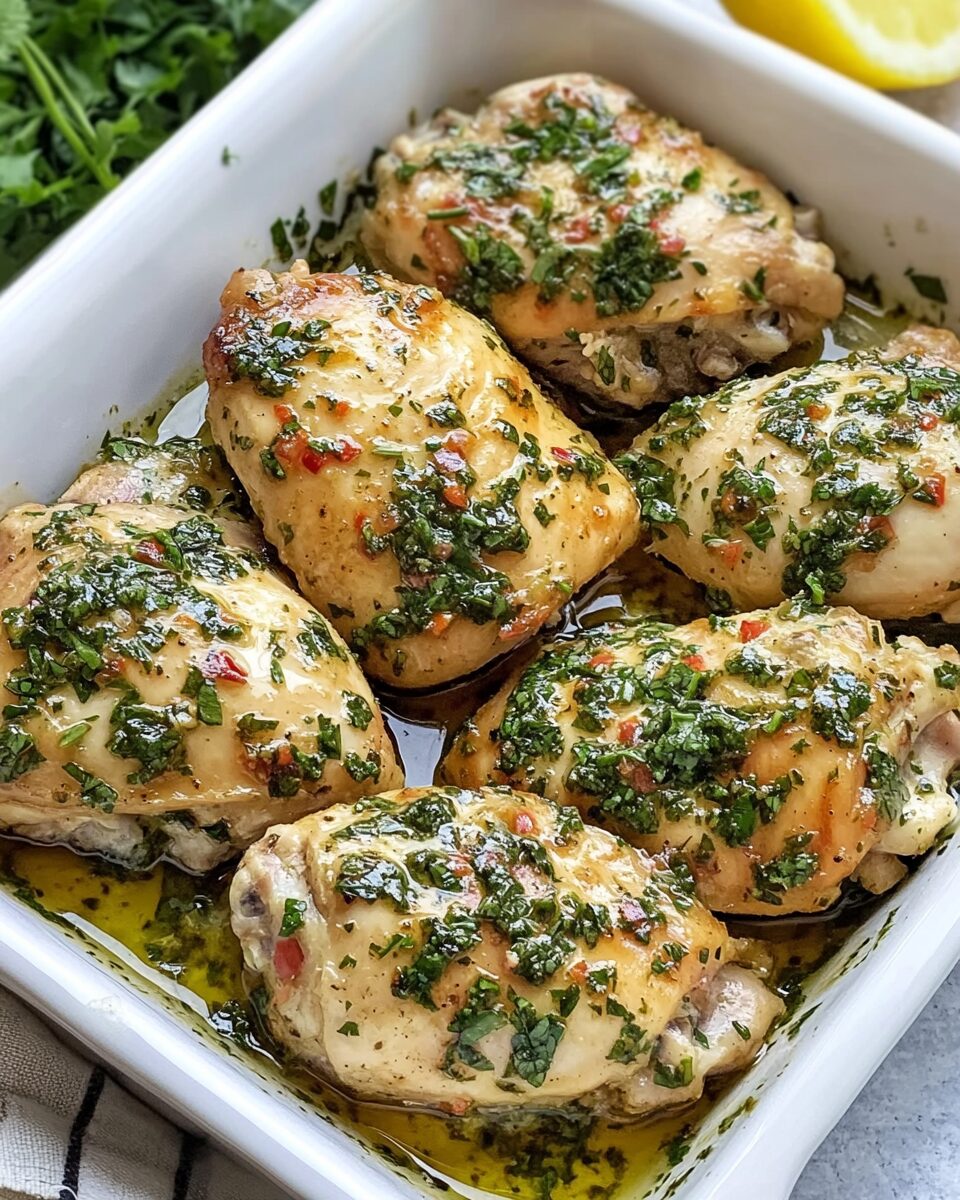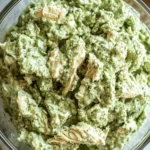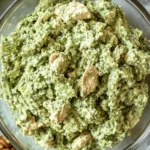This flavorful recipe features juicy chicken thighs marinated in a vibrant homemade chimichurri sauce made with fresh herbs, garlic, and vinegar. It’s a simple yet bold dish perfect for a quick weeknight dinner or a summer barbecue.
FULL RECIPE
Ingredients
- 6 bone-in, skin-on chicken thighs
- 1 cup fresh parsley, finely chopped
- 1/4 cup fresh oregano, finely chopped
- 4 garlic cloves, minced
- 1/2 cup olive oil
- 1/4 cup red wine vinegar
- 1 teaspoon red pepper flakes
- 1/2 teaspoon salt
- 1/2 teaspoon black pepper
Directions
- In a bowl, combine parsley, oregano, garlic, olive oil, red wine vinegar, red pepper flakes, salt, and pepper to make the chimichurri sauce.
- Reserve 1/4 cup of the sauce for serving and set aside.
- Place chicken thighs in a large bowl or resealable bag and pour the remaining chimichurri over them. Toss to coat evenly.
- Cover and marinate in the refrigerator for at least 1 hour or overnight for best flavor.
- Preheat grill or oven to 400°F (200°C).
- Remove chicken from marinade and discard used marinade.
- Grill or bake chicken thighs for 30–35 minutes, or until internal temperature reaches 165°F (74°C) and skin is crispy.
- Serve with the reserved chimichurri sauce drizzled on top.
Nutritional Information
- Calories: 360
- Protein: 22g
- Fat: 28g
- Carbohydrates: 2g
- Fiber: 0.5g
- Sugar: 0g
Flavor Profile of Chimichurri Chicken Thighs
Chimichurri chicken thighs boast a vibrant and zesty flavor profile thanks to the fresh herbs and garlic in the sauce. The parsley and oregano provide earthiness and brightness, while the red wine vinegar adds a tangy kick that cuts through the richness of the chicken. The olive oil balances the acidity with a smooth mouthfeel, and the red pepper flakes introduce a gentle heat that enhances without overpowering. Together, these flavors create a well-rounded and exciting taste experience that complements the juicy, tender chicken thighs perfectly.
The Role of Fresh Herbs in Chimichurri
Fresh herbs are the heart of a great chimichurri sauce. Parsley adds a fresh, slightly peppery note, while oregano contributes a savory depth. Using fresh herbs rather than dried ones ensures the sauce remains bright and lively. The freshness of the herbs also impacts the aroma, making the dish more appetizing and vibrant. Fresh herbs also carry antioxidants and essential oils, which contribute to the overall health benefits and flavor complexity of the sauce.
Why Chicken Thighs Are Ideal for This Recipe
Chicken thighs are naturally more flavorful and moist than chicken breasts because of their higher fat content. This makes them perfect for grilling or roasting, as they stay juicy even at higher cooking temperatures. The skin-on thighs develop a crispy exterior that contrasts beautifully with the tender meat inside. The fat content in thighs also helps absorb and retain the chimichurri flavors better, resulting in a more savory and satisfying dish.
The Importance of Marinating Time
Allowing the chicken to marinate in chimichurri for at least an hour or overnight is crucial to infuse deep flavor. The acidity from the vinegar helps tenderize the meat while the herbs and garlic penetrate the surface. Longer marinating times result in more intense flavor and juicier chicken. Skipping or shortening this step can lead to a less flavorful and dry outcome.
Using Red Wine Vinegar in Chimichurri
Red wine vinegar adds acidity and brightness that balance the oil and herbs in chimichurri. It helps to cut through the richness of the chicken, making each bite refreshing rather than heavy. The vinegar also acts as a mild preservative in the sauce, helping it stay fresh longer when stored properly.
How to Achieve Crispy Chicken Skin
Cooking chicken thighs with the skin on is key to achieving crispy skin. To enhance crispiness, pat the skin dry before cooking to remove moisture. Whether grilling or baking, cooking at a higher temperature helps render the fat under the skin, creating a satisfying crunch. Avoid overcrowding the pan or grill, as this can create steam and prevent crisping.
Grilling vs. Baking: Best Cooking Methods
Both grilling and baking work well for chimichurri chicken thighs, but each offers distinct advantages. Grilling imparts a smoky flavor and crisp texture that complement the herbs in the chimichurri. Baking is more hands-off and allows for even cooking, making it ideal for indoor cooking or when preparing larger batches. The choice depends on your available equipment and desired flavor profile.
Health Benefits of Chimichurri Sauce
Chimichurri is made from fresh herbs and olive oil, both of which provide antioxidants and anti-inflammatory compounds. Parsley is rich in vitamins A, C, and K, which support immune function and bone health. Olive oil is high in heart-healthy monounsaturated fats and polyphenols that promote cardiovascular health. Garlic, a key ingredient, has antimicrobial properties and supports immune defense.
Variations on Classic Chimichurri
Though the traditional recipe uses parsley and oregano, variations can include cilantro, basil, or mint to create different flavor profiles. Some versions add lemon juice instead of vinegar for a lighter acidity or include finely chopped shallots or onions for extra depth. Adjusting the heat level with more or less red pepper flakes allows customization based on preference.
Pairing Suggestions for Chimichurri Chicken Thighs
Chimichurri chicken pairs wonderfully with a variety of sides. Grilled vegetables such as zucchini or bell peppers complement the smoky notes, while a simple rice or quinoa pilaf can soak up extra sauce. Roasted potatoes or a crisp green salad also balance the richness of the dish. For a more authentic experience, serve with crusty bread to mop up the chimichurri.
Storage and Leftover Tips
Leftover chimichurri chicken thighs keep well in the refrigerator for up to three days when stored in an airtight container. Reheat gently in the oven or on the stovetop to preserve moisture and avoid drying out the chicken. The chimichurri sauce can be stored separately and refreshed by stirring in a little fresh olive oil or vinegar before serving again.
Chimichurri in Different Cuisines
Though chimichurri originates from Argentina and Uruguay, it has become popular worldwide for its fresh, herbaceous qualities. Variations of chimichurri can be found in Mediterranean and Latin American cuisines, where the sauce is adapted to local herbs and spices. Its versatility makes it a favorite marinade and condiment across many food cultures.
The Science Behind Marinades
Marinades like chimichurri work by using acid, oil, and seasonings to break down meat fibers and infuse flavor. The acid (vinegar) slightly denatures proteins, making meat more tender, while oil helps distribute fat-soluble flavors. Salt in the marinade helps the meat retain moisture during cooking, resulting in juicier final dishes.
Tips for Selecting Quality Chicken Thighs
Choose chicken thighs that are fresh, with skin that is intact and pale pink in color. Avoid thighs with bruising or an off smell. Organic or free-range chicken can offer better flavor and texture. When possible, buy from a trusted butcher to ensure quality and freshness.
Adapting Chimichurri Chicken for Different Diets
This recipe is naturally gluten-free and can easily be made dairy-free and paleo-friendly. To make it keto-friendly, ensure sides are low-carb vegetables. For those seeking lower fat, skinless thighs can be used, though this will affect moisture and flavor. Adjust seasoning and marinating times to maintain taste with substitutions.
Balancing Heat and Acidity
The red pepper flakes add heat, which balances the acidity of the vinegar and the richness of the chicken. Adjust the amount of red pepper flakes to suit your heat tolerance, remembering that a little goes a long way. The acidity also acts as a palate cleanser between bites, keeping the flavors lively and fresh.
Presentation and Serving Ideas
Serve chimichurri chicken thighs garnished with additional chopped fresh herbs for a bright visual contrast. A drizzle of fresh chimichurri over the plated chicken adds color and moisture. Pair with colorful side dishes to create an inviting and appetizing meal presentation suitable for casual dinners or entertaining.
Common Mistakes to Avoid
Avoid skipping the marinating step, which can lead to bland chicken. Do not overcrowd the cooking surface, as this will cause steaming rather than crisping. Overcooking can dry out the meat, so monitor temperature carefully. Using dried herbs instead of fresh will result in a less vibrant sauce.
Adapting Chimichurri for Other Proteins
Chimichurri sauce is versatile and can enhance other proteins like steak, pork chops, shrimp, or even grilled vegetables. The bold herbaceous and acidic qualities complement the natural flavors and add freshness. Adjust marinating times based on protein thickness and type to avoid overpowering delicate foods.
The Cultural Significance of Chimichurri
Chimichurri holds a cherished place in South American cuisine, particularly in Argentina and Uruguay, where it is a staple condiment for grilled meats during asados (barbecues). It symbolizes conviviality and celebration, often enjoyed in communal meals with family and friends. Its simplicity and bold flavors represent the essence of the region’s culinary traditions.
Conclusion
Chimichurri chicken thighs offer a delicious combination of juicy, tender meat and a vibrant, herbaceous sauce that elevates the dish. The use of fresh herbs, garlic, and vinegar creates a flavor profile that is both bold and balanced. The recipe’s adaptability to various cooking methods and dietary preferences makes it an excellent choice for any occasion. With the right techniques and quality ingredients, this dish delivers a satisfying and flavorful meal that celebrates the freshness and zest of South American cuisine.






